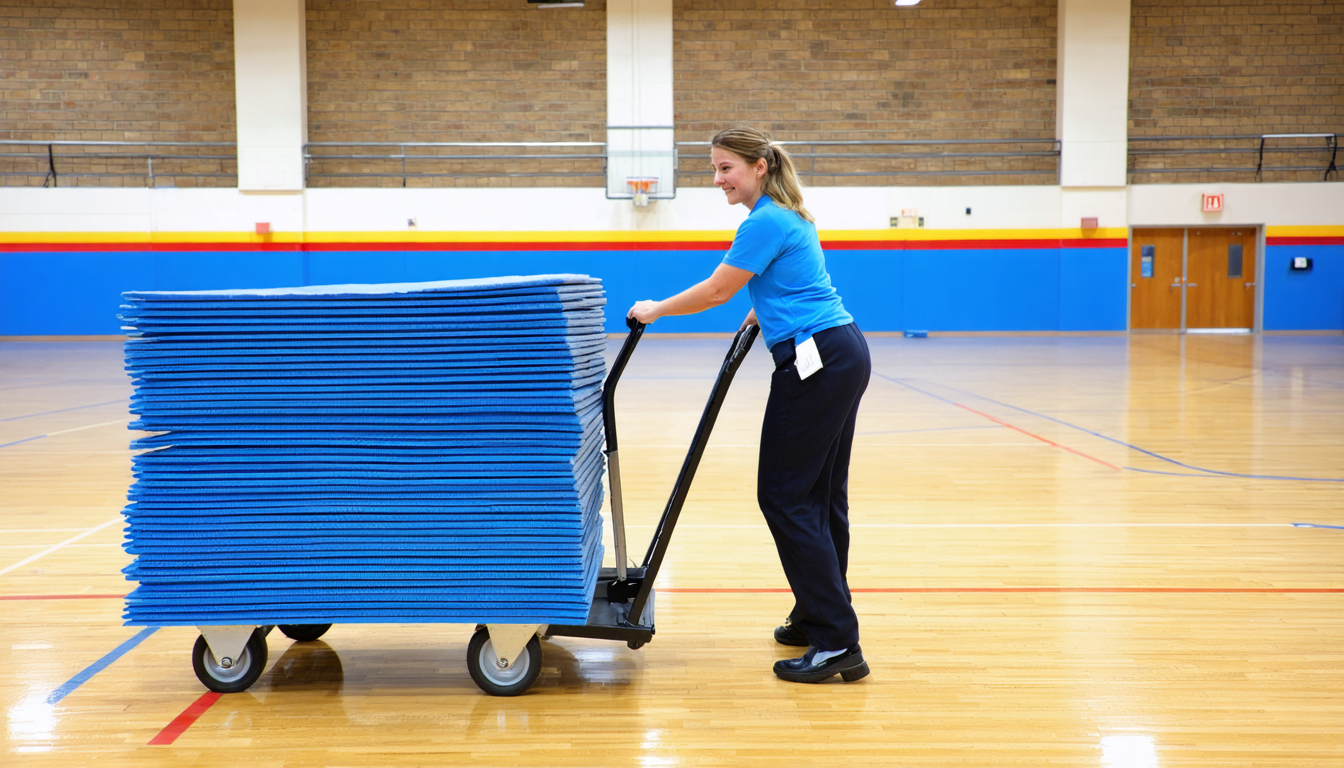Contact with objects and equipment (COE) accidents are a persistent risk for schools, colleges, and universities. The good news? Many COE accidents can be mitigated. By combining strong protocols with smarter technology—like AI-driven video intelligence—education organizations can move from reactive incident response to anticipatory safety. This guide breaks down the true costs, root causes, and provides a clear framework for moving from a reactive to a forward-looking safety model using modern technology.
Why contact with objects and equipment accidents are a significant obstacle for education
COE accidents in education don’t just happen in woodshops or science labs. They show up in cafeterias, gymnasiums, maintenance closets, and playgrounds—anywhere equipment is stored, handled, or maintained. These incidents can lead to severe injuries with high direct costs: $118,837 for amputations and $60,934 for fractures (Source: ElectroIQ). Indirect costs (lost productivity, staff replacement, temporary disruption) are even higher.
The top 5 causes of contact with objects and equipment accidents in education—and forward-thinking ways to mitigate them
Mitigating COE accidents starts with understanding their root causes. Here are the most common causes, what typically goes wrong, and how schools can blend traditional methods with modern video intelligence to reduce the likelihood of future incidents.
1. Caught in or compressed by machinery/equipment
The Hazard:
Picture a maintenance worker clearing a jam in a cafeteria dishwasher, reaching in before the machine is fully powered down—resulting in a crushed hand. Too often, injuries happen during cleaning or maintenance, especially when lockout/tagout procedures are skipped or machine guards are missing.
Traditional Mitigation:
Mandatory lockout/tagout (LOTO) procedures for all maintenance.
Physical guards on all moving parts (e.g., saws, slicers).
Regular staff training and posted signage near hazardous equipment.
How AI Enhances Safety:
AI-powered video analytics can monitor for unauthorized access to restricted equipment areas. “Person enters no-go zone” alerts help supervisors intervene before anyone starts work on energized machinery. Historical video supports rapid review of any incident, speeding up investigations and retraining.
2. Struck by dropped, or moving objects
The Hazard:
A science teacher stacking boxes of glassware on a high shelf loses balance—sending a box tumbling down onto a colleague below. Or, students moving heavy sports equipment drop a weight on their own or a classmate’s foot.
Traditional Mitigation:
Regular safety walkthroughs to spot improper storage.
Training staff and students in safe lifting and stacking.
Use of step stools/ladders rather than standing on chairs.
How AI Reinforces Safety:
The system can flag “crowding” scenarios in busy storage areas, catching unsafe stacking or retrieval behavior. Real-time alerts for “running” or “people absent” in high-risk zones help minimize the likelihood of accidents, especially during busy transitions between classes or activities.
3. Struck against stationary or moving objects
The Hazard:
Consider a student rushing through a hallway who collides with a protruding door or open equipment cart. In another case, a custodian cleaning behind gym bleachers is struck by a moving platform.
Traditional Mitigation:
Clear marking of hazards (e.g., bright tape, warning signs).
Scheduled cleaning and maintenance when spaces are empty.
Awareness campaigns to curb rushing and horseplay.
How AI Bolsters Safeguards:
AI systems can detect and notify staff about running and crowding in known risk areas. Loitering analytics spot when people linger in unsafe zones—prompting timely intervention. Video review capabilities make it easy to analyze incidents and improve procedures.
4. Pinched or crushed by shifting objects

The Hazard:
A teacher repositions a heavy bookcase, and fingers get pinched between the unit and the wall. Or, a student moving stacked gym mats gets their hand trapped as the stack shifts.
Traditional Mitigation:
Training on proper lifting techniques and use of dollies.
Team lifts for heavy or awkward items.
Inspection and maintenance of storage areas to mitigate shifting.
How AI Strengthens Mitigation:
“Person enters no-go zone” detection helps ensure only authorized staff are present during high-risk moves. Video records support root-cause analysis and targeted retraining.
5. Injured by handheld or power tools
The Hazard:
A student using a box cutter to open supplies receives a deep laceration when the knife slips.
Traditional Mitigation:
Mandatory PPE (gloves, goggles) in labs and shops.
Regular tool maintenance and safety checks.
Hands-on training and direct supervision for tool use.
How AI Reinforces Safety:
The system can verify PPE use and flag “missing PPE” in real time. Analytics also highlight “running” behavior in shop classes, offering early warning of unsafe practices. Automated video search shortens investigation time when incidents do occur.
Integrating a modern video AI system: From NVR to AI-driven alerts in education
Upgrading to an insight-driven, AI-powered safety platform doesn’t mean starting over from scratch. Here’s what sets a capable system apart and how it fits into real-world education environments.
Feature |
Traditional NVR System |
Modern video AI platform |
|---|---|---|
Camera Compatibility |
New/specific models only |
Works with existing POE and legacy cameras |
Storage |
On-premise, hardware-heavy |
Secure, cloud-native, scalable |
Maintenance |
Frequent on-site service |
Minimal, remote updates |
User Access |
Limited seats, siloed |
Unlimited users, unified dashboard |
Video Review |
Manual, time-consuming |
AI-powered search and incident detection |
Operational alerts |
Passive footage |
Real-time alerts for COE risks and unsafe acts |
A cloud-based AI camera system bridges your current infrastructure with advanced analytics. There’s no need for a costly “rip-and-replace”—the platform is designed to work with your existing POE or legacy cameras, eliminating the need for full hardware overhaul. All video is stored securely in the cloud, reducing maintenance and scaling as your needs grow. Unlimited user seats and a unified dashboard mean safety, IT, and operations teams can collaborate without bottlenecks.
The system’s pre-trained Video AI Agents act as intelligent teammates. Instead of just recording, the system actively scans for risk: missing PPE, running, unauthorized access, and more. This turns your video network into an anticipatory safety tool, giving teams the information to identify and act on risks as they occur.
Evaluating solutions?
Look for platforms that support compliance (OSHA 1910.132 for PPE, ANSI Z359 for fall protection), mesh with your safety protocols, and deliver operational alerts tailored to education’s specific risks. The best tech doesn’t replace your team—it empowers them to mitigate accident risks and respond faster.
Evolve your approach to COE safety
The risk from COE accidents can be lessened—with the right mix of strong protocols, empowered staff, and smarter technology. The right platform can help your district or campus address risks before they escalate into injuries, streamline investigations, and meet compliance standards with less stress.
Want to see how video AI can help your school or campus lower COE risks? Request a demo to experience Spot AI in action, or explore how our platform supports education safety initiatives.
Frequently asked questions
How can schools and universities guard against COE accidents during maintenance or cleaning?
Enforce strict lockout/tagout (LOTO) procedures, require physical machine guarding, and offer targeted hand safety training. AI-powered camera systems can also monitor for unauthorized access in real-time.
Are there regulatory requirements for machine guarding and PPE in education settings?
Yes. OSHA 29 CFR 1910.132 requires appropriate PPE for hazardous tasks, and 29 CFR 1910.145 mandates hazard warning labels. Machinery must have guards that block contact with moving parts (Source: OSHA).
How does AI video analytics support compliance and investigations?
AI-powered platforms create records of potential safety violations, such as missing PPE or restricted area entry. This speeds up incident investigations, supports OSHA reporting, and delivers visual evidence for audits.
What’s the best way to integrate safety technology with existing camera systems?
Look for solutions that work with your current POE or legacy cameras, offer cloud-native storage, and include unlimited user access. This way, you avoid a costly rip-and-replace and can scale as your needs change.
How can safety technology help reduce stress for safety teams?
Automated alerts, real-time risk detection, and easy video search mean safety teams spend less time on manual reviews and more time on forward-looking safety measures. This lessens administrative hurdle and boosts morale.
What is the best real-time video analytics for safety?
The 'best' real-time video analytics platform is the one that fits your school's unique operational needs. When evaluating options, look for a system that works with your existing cameras to avoid costly replacement, provides AI-powered alerts for specific risks like 'no-go zone' entry, offers secure cloud storage, and simplifies incident investigation with fast, intelligent search to help document compliance.
About the author
Joshua Foster is an IT Systems Engineer at Spot AI, where he focuses on designing and securing scalable enterprise networks, managing cloud-integrated infrastructure, and automating system workflows to enhance operational efficiency. He is passionate about cross-functional collaboration and takes pride in delivering robust technical solutions that empower both the Spot AI team and its customers.

























.png)
.png)
.png)